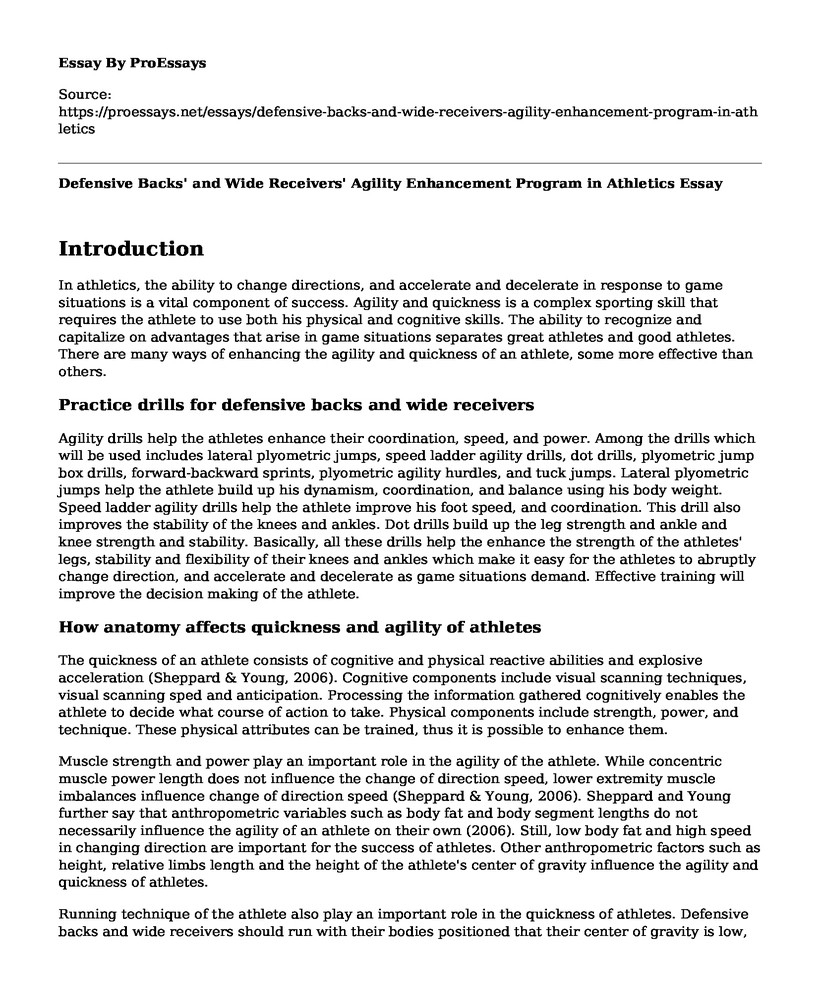Introduction
In athletics, the ability to change directions, and accelerate and decelerate in response to game situations is a vital component of success. Agility and quickness is a complex sporting skill that requires the athlete to use both his physical and cognitive skills. The ability to recognize and capitalize on advantages that arise in game situations separates great athletes and good athletes. There are many ways of enhancing the agility and quickness of an athlete, some more effective than others.
Practice drills for defensive backs and wide receivers
Agility drills help the athletes enhance their coordination, speed, and power. Among the drills which will be used includes lateral plyometric jumps, speed ladder agility drills, dot drills, plyometric jump box drills, forward-backward sprints, plyometric agility hurdles, and tuck jumps. Lateral plyometric jumps help the athlete build up his dynamism, coordination, and balance using his body weight. Speed ladder agility drills help the athlete improve his foot speed, and coordination. This drill also improves the stability of the knees and ankles. Dot drills build up the leg strength and ankle and knee strength and stability. Basically, all these drills help the enhance the strength of the athletes' legs, stability and flexibility of their knees and ankles which make it easy for the athletes to abruptly change direction, and accelerate and decelerate as game situations demand. Effective training will improve the decision making of the athlete.
How anatomy affects quickness and agility of athletes
The quickness of an athlete consists of cognitive and physical reactive abilities and explosive acceleration (Sheppard & Young, 2006). Cognitive components include visual scanning techniques, visual scanning sped and anticipation. Processing the information gathered cognitively enables the athlete to decide what course of action to take. Physical components include strength, power, and technique. These physical attributes can be trained, thus it is possible to enhance them.
Muscle strength and power play an important role in the agility of the athlete. While concentric muscle power length does not influence the change of direction speed, lower extremity muscle imbalances influence change of direction speed (Sheppard & Young, 2006). Sheppard and Young further say that anthropometric variables such as body fat and body segment lengths do not necessarily influence the agility of an athlete on their own (2006). Still, low body fat and high speed in changing direction are important for the success of athletes. Other anthropometric factors such as height, relative limbs length and the height of the athlete's center of gravity influence the agility and quickness of athletes.
Running technique of the athlete also play an important role in the quickness of athletes. Defensive backs and wide receivers should run with their bodies positioned that their center of gravity is low, lean forward and use short strides to enhance their agility. To achieve this, knee joints and ankles play an important role. As such, it is of great importance that the athlete is put through drills that increase the strength and stability of the knees and ankles.
Cognitive apparatus used by athletes include the nervous system and a variety of sensory input systems like auditory, visual, and somatosensory systems. These two systems enable the athlete to process information and help him come to a decision in the course of play. The senses gather information about the patterns that indicate the opponent position and play and use the information to his advantage. The speed at which this information is processed and utilized depends on the stimulus clarity, intensity, and experience (Dawes & Roozen, 2012).
References
Sheppard, J.M., and Young, W.B., (2006). Agility literature review: classifications, training, and testing. Journal of sports science. PP. 2-16
Dawes, J. and Roozen, M. (2012). Developing agility and quickness. National Strength and Conditioning Association. ISBN-13: 978-0-7360-8326-3
Grand, T. I. (1976). The anatomical basis of locomotion. The American Biology Teacher, 38(3), 150-156.
Twist, P. W., & Benicky, D. (1996). Conditioning Lateral Movement for Multi-Sport Athletes: Practical Strength and Quickness Drills. Strength & Conditioning Journal, 18(5), 10-19.
Rajkovic, A., Vucetic, V., & Basic, D. (2014). Influence of specific speed, agility, and quickness training (SAQ) on speed and explosiveness of football players. Sports Science, 7(1), 48-51.
Rajkovic, A., Vucetic, V., & Basic, D. (2014). Influence of specific speed, agility, and quickness training (SAQ) on speed and explosiveness of football players. Sports Science, 7(1), 48-51.
Cite this page
Defensive Backs' and Wide Receivers' Agility Enhancement Program in Athletics. (2022, Jun 06). Retrieved from https://proessays.net/essays/defensive-backs-and-wide-receivers-agility-enhancement-program-in-athletics
If you are the original author of this essay and no longer wish to have it published on the ProEssays website, please click below to request its removal:
- Should College Football Athletes Be Paid?
- Research Paper on European Football
- Essay Sample on Asian Football: Striving for Global Competitiveness
- Essay Example on Athletes for Change: The Power of Sports for Social Change
- Paper Example on itamin C: Nature's Antioxidant & Essential Metabolism Booster
- Essay Example on Plyometrics: Increase Endurance, Strength, Agility & Speed
- Paper Sample: Athletes Unite for Social Justice Awareness







